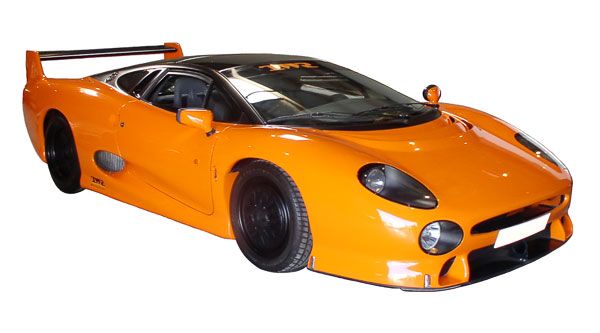
Jaguar executives who saw the concept were sufficiently impressed to formally commit company resources to producing a car for the 1988 British Motor Show. Tom Walkinshaw Racing was engaged to produce a 6.2-litre version of Jaguar's V12 engine with four valves per cylinder, quad camshafts, and a target output of 500 hp (370 kW; 510 PS). The all-wheel drive system was produced by FF Developments, who had experience with such systems going back to the 1960s and the Jensen FF. The styling of the car was done by Keith Helfet and included scissor-style doors similar to those in use by Lamborghini in several of their cars. The name "XJ220" was assigned as a reference to the targeted top speed of 220 mph (350 km/h).
 Emazing Purple Jaguar XJ220
Emazing Purple Jaguar XJ220  Black Jaguar XJ220 Concept
Black Jaguar XJ220 Concept
The prototype car was significantly heavier at 1,560 kg (3,439 lb) than other Jaguar racers like the XJR-9. But as it was intended to be, first and foremost, a roadcar, it would be more appropriate to compare it with something like the XJS; in spite of being 30-inch (762 mm) longer and 10-inch (254 mm) wider and even with the added weight of the all-wheel drive system, the XJ220 was still 170 kg (375 lb) lighter than the XJS.
 Orange Jaguar XJ220 Looks so Sporty
Orange Jaguar XJ220 Looks so Sporty Silver Jaguar XJ220 Front View
Silver Jaguar XJ220 Front View
The car was officially announced in 1989 with a price of £361,000 ($580,000 USD) and prospective buyers were expected to put up a deposit of £50,000 ($80,000 USD) to be put on the waiting list for delivery. Because Jaguar promised to limit initial production to 220 units and that total production would not exceed 350, many of those who put deposits on the cars were speculators who intended to sell the car at an immediate profit.
 Jaguar executives who saw the concept were sufficiently impressed to formally commit company resources to producing a car for the 1988 British Motor Show. Tom Walkinshaw Racing was engaged to produce a 6.2-litre version of Jaguar's V12 engine with four valves per cylinder, quad camshafts, and a target output of 500 hp (370 kW; 510 PS). The all-wheel drive system was produced by FF Developments, who had experience with such systems going back to the 1960s and the Jensen FF. The styling of the car was done by Keith Helfet and included scissor-style doors similar to those in use by Lamborghini in several of their cars. The name "XJ220" was assigned as a reference to the targeted top speed of 220 mph (350 km/h).
Jaguar executives who saw the concept were sufficiently impressed to formally commit company resources to producing a car for the 1988 British Motor Show. Tom Walkinshaw Racing was engaged to produce a 6.2-litre version of Jaguar's V12 engine with four valves per cylinder, quad camshafts, and a target output of 500 hp (370 kW; 510 PS). The all-wheel drive system was produced by FF Developments, who had experience with such systems going back to the 1960s and the Jensen FF. The styling of the car was done by Keith Helfet and included scissor-style doors similar to those in use by Lamborghini in several of their cars. The name "XJ220" was assigned as a reference to the targeted top speed of 220 mph (350 km/h). The prototype car was significantly heavier at 1,560 kg (3,439 lb) than other Jaguar racers like the XJR-9. But as it was intended to be, first and foremost, a roadcar, it would be more appropriate to compare it with something like the XJS; in spite of being 30-inch (762 mm) longer and 10-inch (254 mm) wider and even with the added weight of the all-wheel drive system, the XJ220 was still 170 kg (375 lb) lighter than the XJS.
The prototype car was significantly heavier at 1,560 kg (3,439 lb) than other Jaguar racers like the XJR-9. But as it was intended to be, first and foremost, a roadcar, it would be more appropriate to compare it with something like the XJS; in spite of being 30-inch (762 mm) longer and 10-inch (254 mm) wider and even with the added weight of the all-wheel drive system, the XJ220 was still 170 kg (375 lb) lighter than the XJS. The car was officially announced in 1989 with a price of £361,000 ($580,000 USD) and prospective buyers were expected to put up a deposit of £50,000 ($80,000 USD) to be put on the waiting list for delivery. Because Jaguar promised to limit initial production to 220 units and that total production would not exceed 350, many of those who put deposits on the cars were speculators who intended to sell the car at an immediate profit.
The car was officially announced in 1989 with a price of £361,000 ($580,000 USD) and prospective buyers were expected to put up a deposit of £50,000 ($80,000 USD) to be put on the waiting list for delivery. Because Jaguar promised to limit initial production to 220 units and that total production would not exceed 350, many of those who put deposits on the cars were speculators who intended to sell the car at an immediate profit.




Комментариев нет:
Отправить комментарий